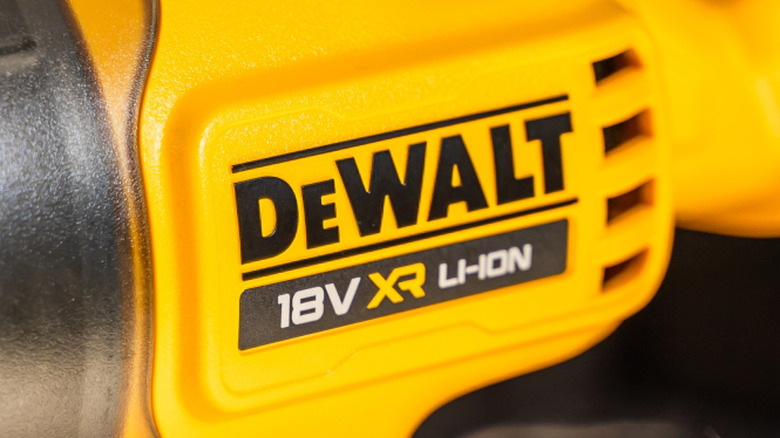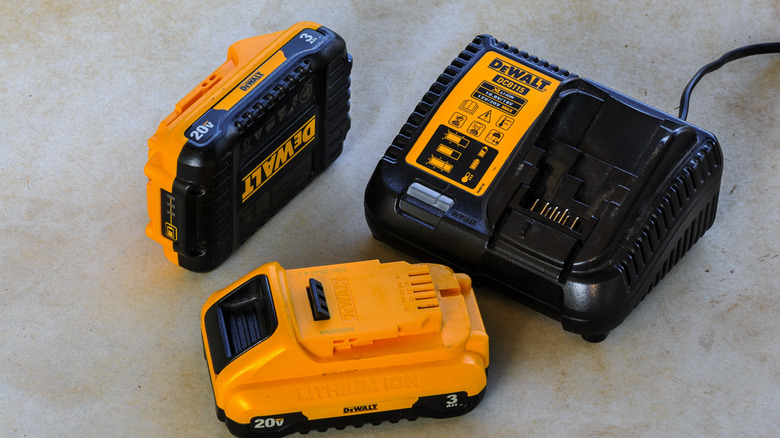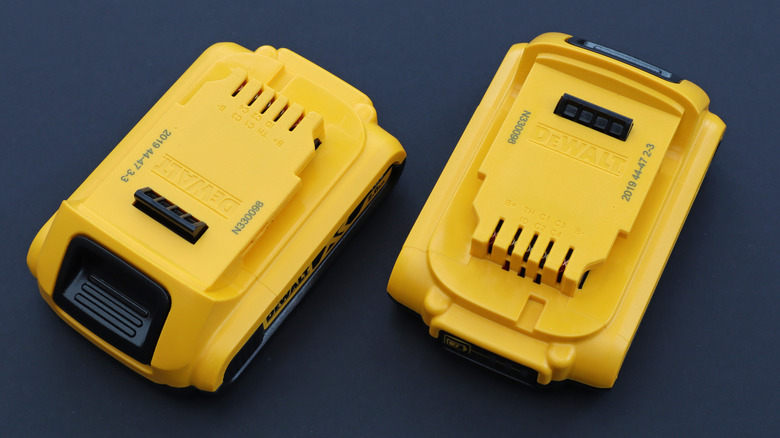When (And Why) Did DeWalt Discontinue Its 18V Batteries?
Like most other major tool brands currently on the market, DeWalt has gone all-in on battery power. The brand's countless tools have almost completely done away with corded power, allowing users more physical freedom with as little compromise on performance as possible. Naturally, this fundamental change to DeWalt's catalogue has led to the establishment of its handy battery system. DeWalt currently produces 12, 20, and 60-volt batteries for its tools in the United States. It has even innovated with the creation of the adaptable Flexvolt line, along with the high-performance, pouch cell-equipped Power Stack assortment.
While this innovation is well and good, it has come at the expense of past breakthroughs. Just as there are numerous DeWalt tools we wish weren't discontinued, there have been some retirements in the DeWalt battery world as well. Most notably, DeWalt made the decision to retire its line of 18V batteries. This change is far from new, with the seeds being planted for it all the way back in 2011. That's the year the brand began pushing 18V to the wayside, though it continued to produce 18V batteries and tools until 2022. This is the year that the line was well and truly laid to rest.
This covers the timeline of when DeWalt first elected to get rid of its 18V batteries and ultimately followed through. The question remains, however, why did the battery type end up retired?
18V batteries were retired for multiple reasons
DeWalt's decision to discontinue its 18V battery line came as a result of a few factors. For one, there were sweeping changes across the power tool world that meant the existing 18V design had run its course. For some time, nickel-cadmium batteries were the standard for power tools. By the 2000s and 2010s, though, they had been largely replaced by much more durable and reliable lithium-ion batteries. Thus, to keep up with the times and remain on the cutting-edge of tool battery technology, DeWalt shifted its focus from nickel-cadmium batteries to lithium-ion and let a large portion of the 18V line go.
This isn't to say that DeWalt couldn't have just created a full lithium-ion 18V battery line, and there were lithium-ion 18V units sold, but it did have something else in mind. As mentioned previously, 2011 was the year DeWalt's 18V batteries began to take a backseat. This was because DeWalt's 20V battery line was introduced that year, which also brought on a host of 20V tools to complement the new batteries. At the time of publication, DeWalt's 20V lineup has expanded remarkably to include well over 300 different tools, making it abundantly clear, if it wasn't already, that the 18V system is truly a thing of the past. There are even options, as evidenced by the differences between DeWalt's 20V Max and 20V Max XR batteries.
At this point, 18V DeWalt is receding further into history, while 20V is looked at as the modern and superior system. In reality, though, they're not as different as one might think.
DeWalt's 18V and 20V batteries don't differ too much
Since 20 is bigger than 18, one would think that a 20V DeWalt battery is an automatic step up from an 18V unit. Breaking them down to their internal components, though, their differences are surprisingly negligible. Within each battery is a set of battery cells, specifically in groups of five, known as a series. Each individual cell has two voltage ratings to note. The nominal voltage is the voltage required to operate at its fullest, while the maximum voltage is what it can operate at without sustaining any damage or malfunction. This distinction is the key to understanding the trickery behind the 18V and 20V labels.
Speaking to 18V and 20V batteries, each cell carries a nominal voltage of 3.6 and a maximum voltage of 4. Multiply each of these by the five cells, and you have 18 and 20 volts, respectively. With all of that said, yes, DeWalt's 18V and 20V labels are merely marketing talk. One uses nominal voltage in its advertising, while the other uses maximum voltage to create the illusion of innovation — the 20V Max branding not-so-subtly hinting at this. The two battery types offer the same level of power. In some regions, like the United Kingdom, 18V DeWalt batteries are still technically sold in the era of 20V, using nominal voltage to advertise rather than maximum.
At the end of the day, while DeWalt's 18V and 20V batteries aren't quite interchangeable, they're a lot less different than people realize. Still, with 20V now the standard in the United States, don't expect an 18V-branded comeback anytime soon.


